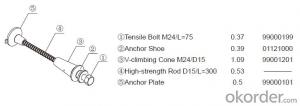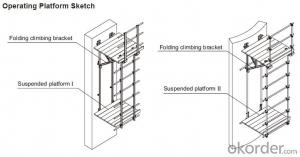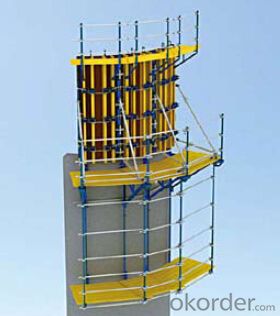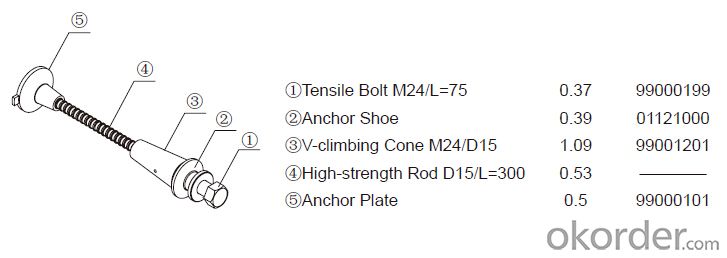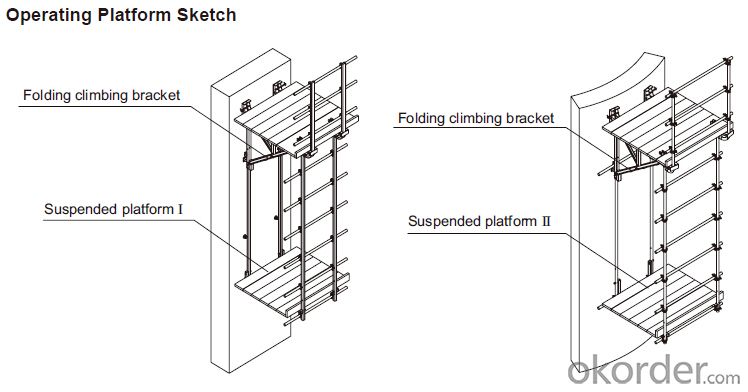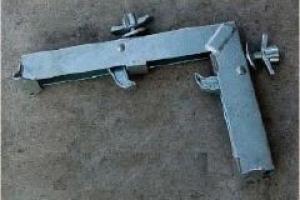Climbing Platform CP-190 for formwork and scaffolding systems
- Loading Port:
- Tianjin
- Payment Terms:
- TT OR LC
- Min Order Qty:
- 50 m²
- Supply Capability:
- 1000 m²/month
OKorder Service Pledge
OKorder Financial Service
You Might Also Like
Climbing Platform CP190
Climbing bracket CP190 is mainly used as operating platform during construction. It can be used
on the vertical wall and arced wall. The bracket hang on the anchor system and all the load are
supported by anchor system. It’s convenient to assemble and dismantle, the construction is easy,
rapid and safe.
Anchor System:
Anchor system is the most important supporting part. The system is made of five parts shown
below. There into, tensile bolt, anchor shoe and V-climbing cone can be taken out for reusing.
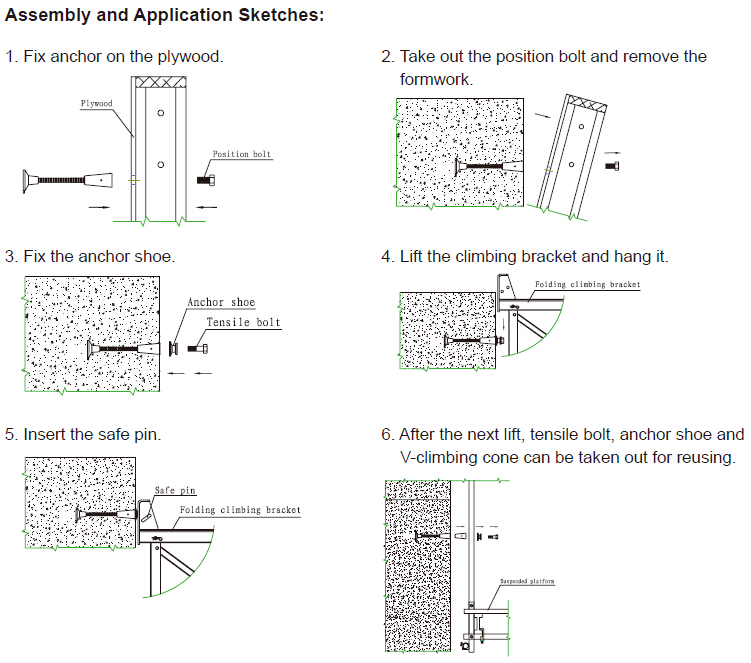
- Q: What are the different quality control measures for steel formwork construction?
- Steel formwork construction commonly implements several quality control measures to guarantee the quality and integrity of the final product. Some of these measures include: 1. Inspection of materials: Prior to commencing construction, thorough inspections are conducted on all steel formwork materials to ensure they meet the necessary specifications and standards. This entails checking for defects, such as cracks or deformations, and verifying the quality of the steel used. 2. Welding inspections: Welding is often required to join different components of steel formwork structures. Regular inspections are crucial to ensure that all welded joints are executed properly and meet the required strength and quality standards. This involves checking for proper penetration, weld size, and alignment, as well as conducting non-destructive testing if necessary. 3. Dimensional checks: Accurate dimensions are vital for the proper assembly and functionality of steel formwork structures. Throughout the construction process, regular dimensional checks are conducted to ensure that all components are fabricated to the correct specifications. This includes verifying the lengths, widths, and thicknesses of plates, beams, and other structural elements, as well as checking for proper alignment and positioning. 4. Surface finish inspection: The surface finish of steel formwork components significantly affects their performance and durability. Regular inspections are carried out to ensure that all surfaces are free from defects such as roughness, cracks, corrosion, or any other imperfections that could compromise the structure's integrity. 5. Load testing: Load testing is a crucial quality control measure for steel formwork construction. It involves subjecting the formwork structures to a predetermined load to ensure they can withstand the expected forces during use. Load testing can be performed using various methods, including static or dynamic load tests, and helps ensure the structural stability and safety of the formwork. 6. Documentation and record keeping: Proper documentation and record keeping of all quality control measures performed during steel formwork construction are essential. This includes recording the results of inspections, tests, and any corrective actions taken. Documentation facilitates traceability, provides a reference for future inspections, and ensures compliance with relevant standards and regulations. By implementing these quality control measures, steel formwork construction companies can guarantee that their structures meet the required standards, are safe and durable, and provide reliable support during the concrete pouring process.
- Q: Can steel formwork be easily disassembled and removed after construction?
- Certainly! After construction, it is possible to easily disassemble and remove steel formwork. These formwork systems are specifically designed to be reusable and offer great flexibility when it comes to assembly and disassembly. Typically, the components of steel formwork are lightweight, making them easily manageable and movable by construction workers. Furthermore, steel formwork systems often incorporate adjustable clamps and brackets, enabling swift and efficient dismantling. This not only saves time and labor costs but also permits the reuse of the formwork in future construction endeavors, making it an environmentally-friendly and cost-effective option for construction projects.
- Q: Can steel formwork be used for different types of concrete finishes?
- Yes, steel formwork can be used for different types of concrete finishes. Steel formwork is versatile and can be easily adjusted and customized to achieve different finishes, such as smooth, textured, or patterned surfaces. It provides a strong and rigid structure, allowing for precise shaping and detailing of the concrete. Additionally, steel formwork can be reused multiple times, making it cost-effective for various types of concrete finishes.
- Q: Can steel formwork be used for marine construction projects?
- Yes, steel formwork can be used for marine construction projects. Steel has excellent strength and durability, making it suitable for withstanding the harsh marine environment. It offers stability and resistance to corrosion, making it a reliable choice for constructing structures in or near the water.
- Q: Are there any specific safety measures to be followed during steel formwork installation?
- Yes, there are specific safety measures that should be followed during steel formwork installation. These measures include ensuring proper training and supervision of personnel, using appropriate personal protective equipment (such as gloves, safety glasses, and hard hats), conducting regular inspections of the formwork for any damages or defects, securing the formwork to prevent dislodgement or collapse, and implementing proper fall protection measures when working at heights. Additionally, it is crucial to follow manufacturer's instructions and industry standards to ensure safe and successful steel formwork installation.
- Q: How does steel formwork impact the overall project budgeting?
- The overall project budgeting can be significantly affected by steel formwork. Although the initial cost of steel formwork may be higher compared to wood or plastic formwork, it offers several advantages that can help offset the initial investment. To begin with, steel formwork is renowned for its durability and longevity. Unlike wood or plastic formwork, steel formwork can be reused multiple times without compromising its structural integrity. This reusability factor reduces the need for frequent replacement or repair, resulting in long-term cost savings. Furthermore, steel formwork provides a superior finish to concrete structures. The smooth and even finish achieved with steel formwork minimizes the need for additional surface treatments or finishing work, leading to cost savings. Moreover, steel formwork offers increased strength and stability, enabling the construction of larger and more complex structures. This eliminates the necessity for additional support systems or reinforcements, which can be costly and time-consuming. Additionally, steel formwork is easy to assemble and dismantle, resulting in faster construction times. The quick turnaround time reduces labor costs and allows for earlier project completion, which is particularly advantageous for time-sensitive projects. Lastly, steel formwork is resistant to adverse weather conditions, such as moisture or extreme temperatures, which can negatively impact the effectiveness and lifespan of the formwork. This resistance reduces the risk of formwork damage and replacement costs, contributing to cost savings. In conclusion, while steel formwork may have a higher upfront cost, its durability, reusability, high-quality finish, strength, ease of use, and resistance to weather conditions can all contribute to cost savings in terms of reduced labor, material, and maintenance expenses. Therefore, steel formwork can positively impact the overall project budgeting.
- Q: Can steel formwork be used for precast concrete balconies?
- Yes, steel formwork can be used for precast concrete balconies. Steel formwork is commonly used in construction for various applications, including precast concrete elements. It offers several advantages such as durability, strength, and flexibility. Steel formwork can be easily fabricated to the required dimensions and shapes, allowing for the creation of complex balcony designs. It also provides a smooth finish to the concrete surface, reducing the need for additional finishing work. Furthermore, steel formwork can be reused multiple times, making it a cost-effective option for precast concrete balconies.
- Q: Are there any specific safety guidelines for steel formwork installation?
- Yes, there are specific safety guidelines for steel formwork installation. Here are some key safety measures that should be followed: 1. Training and Competency: All personnel involved in the steel formwork installation should receive proper training and be competent in their roles. This includes knowledge of the equipment, understanding of the installation procedures, and awareness of potential hazards. 2. Personal Protective Equipment (PPE): Workers should wear appropriate PPE, such as hard hats, safety glasses, gloves, and steel-toed boots, to protect against potential head injuries, eye injuries, hand injuries, and foot injuries. 3. Inspection and Maintenance: The steel formwork and all associated equipment should be inspected regularly to identify any defects or hazards. Any damaged or faulty parts should be repaired or replaced immediately to ensure safety during installation. 4. Hazard Identification and Control: Prior to installation, a thorough assessment of the work area should be conducted to identify potential hazards, such as overhead power lines, uneven ground, or confined spaces. Adequate measures should be taken to control these hazards, such as erecting barriers, using warning signs, or implementing fall protection systems. 5. Manual Handling: Proper lifting techniques should be used to prevent back injuries or strains. The use of mechanical aids, such as cranes or hoists, should be considered for heavy or awkward loads. 6. Fall Protection: Fall hazards are common during steel formwork installation, especially when working at heights. Adequate fall protection systems, such as guardrails, safety nets, or personal fall arrest systems, should be used to prevent falls and protect workers. 7. Communication and Coordination: Clear communication and coordination among the installation team is essential for a safe installation process. This includes regular safety briefings, ensuring everyone understands their roles and responsibilities, and maintaining an open line of communication for reporting any safety concerns. It is crucial to note that these guidelines may vary depending on the specific project, local regulations, and industry standards. Therefore, it is recommended to consult with relevant authorities, such as the project engineer or site safety officer, to ensure compliance with all necessary safety requirements.
- Q: How does steel formwork compare to timber formwork in terms of durability?
- Steel formwork is generally considered to be more durable than timber formwork. Steel is a strong and resilient material that is able to withstand heavy loads and high pressures without warping or deteriorating. Unlike timber, steel does not rot, warp, or shrink when exposed to moisture or extreme weather conditions. This makes steel formwork suitable for use in various construction projects, including high-rise buildings, bridges, and tunnels, where durability is essential. Additionally, steel formwork has a longer lifespan than timber formwork. Steel is known for its longevity and ability to maintain its structural integrity over time. It does not require frequent replacement or repairs, resulting in cost savings in the long run. Timber formwork, on the other hand, may need to be replaced more frequently due to wear and tear, moisture damage, or insect infestation. Furthermore, steel formwork offers greater flexibility and adaptability. It can be easily fabricated into different shapes and sizes to meet the specific requirements of each construction project. This adaptability allows for efficient and precise construction, reducing labor and material costs. Overall, while timber formwork can be cost-effective and suitable for certain applications, steel formwork is generally considered to be more durable, long-lasting, and versatile. It provides a reliable and resilient solution for construction projects that require high strength and durability.
- Q: Can steel formwork be used in bridge construction?
- Yes, steel formwork can be used in bridge construction. Steel formwork is a durable and versatile option that can withstand the heavy loads and harsh environmental conditions associated with bridge construction. It offers the required strength and stability to support the concrete during the construction process, ensuring the bridge's structural integrity. Additionally, steel formwork can be easily assembled, disassembled, and reused, making it a cost-effective choice for bridge construction projects.
Send your message to us
Climbing Platform CP-190 for formwork and scaffolding systems
- Loading Port:
- Tianjin
- Payment Terms:
- TT OR LC
- Min Order Qty:
- 50 m²
- Supply Capability:
- 1000 m²/month
OKorder Service Pledge
OKorder Financial Service
Similar products
Hot products
Hot Searches
Related keywords

